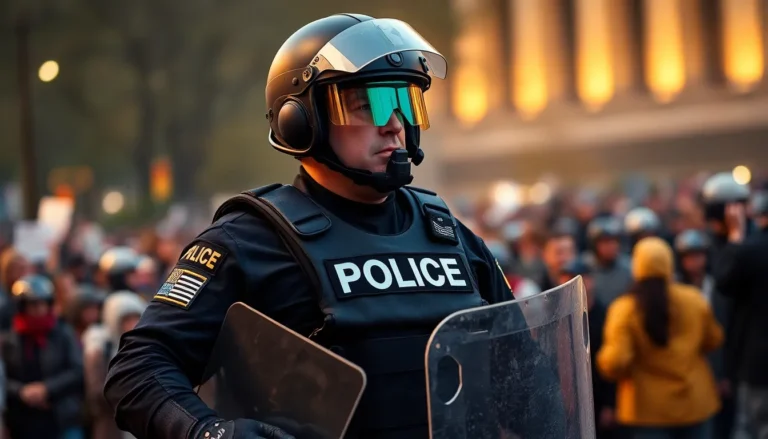In a world where a single drop can turn a pristine lens into a paperweight, camera gear insurance isn’t just smart—it’s essential. Imagine capturing the perfect sunset, only to trip over your own shoelaces and send your beloved camera flying. Ouch! That’s a nightmare no photographer wants to face. But with the right insurance, those heart-stopping moments can become just a funny story to tell at parties.
Camera gear can be a hefty investment, and protecting it should be a top priority. Whether it’s a rogue wave at the beach or a curious toddler with sticky fingers, life has a way of throwing curveballs. Investing in camera gear insurance means peace of mind, allowing photographers to focus on their craft instead of worrying about what might go wrong. So grab your gear and let’s dive into the world of camera gear insurance—it might just save your sanity.
Table of Contents
ToggleUnderstanding Camera Gear Insurance
Camera gear insurance protects valuable equipment against damage, theft, and loss. This coverage provides photographers with the assurance needed to focus on their work without worrying about their gear.
What It Covers
Camera gear insurance typically covers damages from accidents, such as drops or spills. Coverage often includes theft, whether from a venue, vehicle, or an unattended location. Many policies also protect against equipment loss during transit or while on assignment. Additionally, optional coverage may protect against equipment malfunction not covered by a manufacturer’s warranty. Photographers should review policy details to ensure they understand what is included and exclude any potential gaps in coverage.
Why It’s Important
Importance lies in safeguarding substantial investments photographers make in gear. Equipment failure or accidents can lead to costly repairs or replacements. Without insurance, unexpected damages can disrupt business operations and threaten financial stability. Having the right insurance allows photographers to focus on their creative processes rather than worrying about potential mishaps. Peace of mind enables photographers to capture images without hesitation, knowing their gear is protected. Prioritizing insurance helps mitigate risks associated with professional photography.
Types of Camera Gear Insurance

Various types of camera gear insurance cater to photographers’ specific needs. Understanding these options enables photographers to select the best coverage for their equipment.
Comprehensive Coverage
Comprehensive coverage protects against a wide range of potential issues. Accidents like drops or water damage often fall under this type of insurance. Coverage typically includes theft, loss, or damage during transport. Many policies also extend to cover gear, even during events like natural disasters. Photographers benefit from peace of mind knowing their investments are secure. The extensive nature of this coverage often makes it the preferred choice for serious professionals.
Specialized Coverage
Specialized coverage focuses on specific risks associated with photography. This form of insurance often includes unique provisions for items such as drones or underwater camera systems. Photographers using these specialized tools often face niche challenges not covered by standard policies. Customizable options allow photographers to tailor coverage to fit their equipment and work environment. Additional coverage can protect against equipment failure and professional liability. These unique features make specialized coverage essential for varied photographic disciplines.
How to Choose the Right Policy
Selecting the right camera gear insurance policy requires careful consideration of specific needs and provider options.
Assessing Your Needs
Identifying coverage requirements is crucial. Photographers should evaluate the total value of their equipment, including lenses and accessories. Determining the types of risks most likely to affect their gear provides insight into necessary protections. For instance, full-time professionals may require extensive coverage due to higher usage and travel frequency. Casual shooters might opt for a more basic policy but must still factor in potential hazards such as theft during events. Assessing individual circumstances ensures protection aligns with personal usage patterns.
Comparing Insurance Providers
Researching insurance providers is essential for making an informed choice. Checking for established companies with strong reputations in the photography community provides reassurance. Reading customer reviews offers insights into claims processes and customer service experiences. Comparing policy terms helps highlight coverage limitations and exclusions. Notably, some providers specialize in gear insurance, offering comprehensive policies designed specifically for photographers. A detailed analysis of provider offerings ensures the selected plan meets all requirements.
Tips for Filing a Claim
Understanding the claims process is crucial for photographers ensuring a smooth experience when addressing damages or losses. Knowing the necessary documentation and potential pitfalls enhances the likelihood of a successful claim.
Documentation Required
Gathering the right documentation helps streamline the claims process. Receipts for all camera gear purchased provide proof of ownership and value. Photographers should also include photographs of the equipment, especially those showing damage or theft. Additionally, maintaining records of previous insurance policies can aid significantly. In some cases, police reports might also be necessary, particularly in theft situations. These documents collectively substantiate the claim, making it easier for insurers to process.
Common Pitfalls to Avoid
Avoiding common pitfalls can prevent delays or denials in the claims process. Failing to report incidents quickly can lead to complications, as insurance policies often mandate prompt reporting. Neglecting to read the policy’s fine print might result in confusion about coverage limits. Many photographers also underestimate the importance of detailed documentation, thinking a simple description suffices. Overlooking deadlines for submitting claims poses additional risks for photographers. Each of these missteps could jeopardize the claim’s success, making caution essential throughout the process.
Investing in camera gear insurance is a crucial step for any photographer serious about their craft. It not only protects valuable equipment but also allows creatives to focus on their art without the looming worry of potential mishaps. By understanding the various coverage options available and tailoring policies to fit individual needs, photographers can ensure their gear is safeguarded against unforeseen events.
Moreover, being well-informed about the claims process and necessary documentation can significantly enhance the likelihood of a successful claim. With the right insurance in place photographers can navigate their professional journey with confidence knowing their equipment is protected. Prioritizing this aspect of their business is essential for long-term success and peace of mind.








